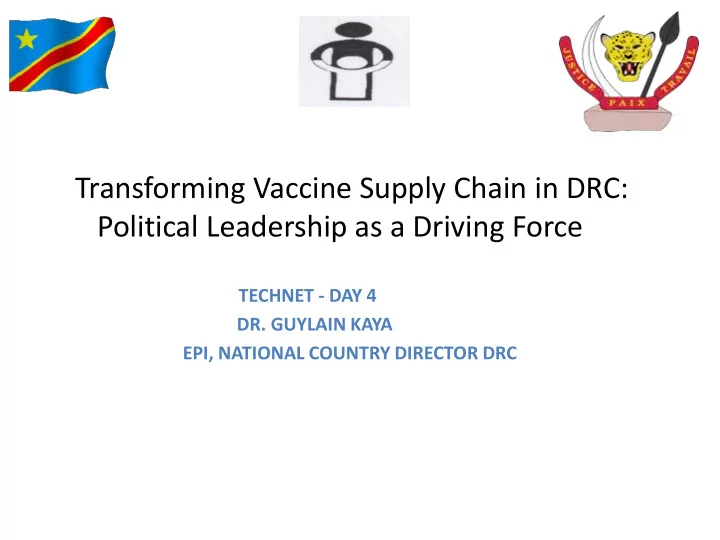

Transforming Vaccine Supply Chain in DRC: Political Leadership as a Driving Force TECHNET - DAY 4 DR. GUYLAIN KAYA EPI, NATIONAL COUNTRY DIRECTOR DRC
Outline • DRC Context • DRC supply chain challenges • Distribution is Complex and Expensive • Moving to Decentralize Distribution • Support for a System Design Approach • Modeling • NGCA Initiative in Equateur DRC • NGCA: Accomplishments and Learning • Political Leadership as a Driving Force for Successful Change • Next Steps • My Aim
DRC Context Decentralized health system Large and diverse • Largest country in SSA – • 26 provinces and 516 2.3M km2 Health districts • 94M people 60% rural A robust health system foundation • 3.8M live births • WPV controlled since 6 years • 8830 health centers • 4350 new refrigerators • 44 cold rooms at provincial levels • 20 cold rooms at national
Supply Chain challenges: Why DRC’s Supply Chain Is a «Casse-Tête » Accessibility • Large distances • Difficult roads • High transport costs • Staff unstable and not HR motivated • Insufficient supervision Cold Chain • Insufficient cold chain • Lack of maintenance
Distribution is Complex and Expensive • Single point of entry • 80% distribution by plane • More than 27 destinations • More than USD$2M yearly
Moving to Decentralize Distribution Before After 6
Support for a System Design Approach • Open to innovation Inspired by other countries’ experiences New approaches allowing more flexibility Better understanding of barriers between provincial medical stores and health centers • Commitment to invest necessary resources Financial Human resources Political will • Embarking on this journey with the strong engagement and collaboration of all key stakeholders
Modeling for helping stakeholders identify opportunities for improvement Key questions: • How do we most efficiently access hard-to-reach areas while increasing availability? • Is CCE capacity sufficient? • Is resource sharing between programs a feasible strategy at lower levels?
NGCA Initiative in Equateur DRC: an informed and budgeted action plan iSC design changes ‒ Direct delivery from provincial warehouse to a sub-set of “accessible” SDPs ‒ “Inaccessible” SDPs resupplied from the closest/lest costly to access site with CCE, regardless of whether it is a zonal warehouse or another SDP ‒ Two-month resupply cycle for rural zones Professionalization of logistics Distribution by logistics professionals = opportunity for QA + supervision and time savings for zones and SDPs Coordination and resource sharing Transport of commodities across all health programs is coordinated and, where feasible, integrated ‒ Modeling shows that EPI products use <10% of vehicle/boat capacity leaving sufficient space for non-EPI products 9
NGCA: Accomplishments and Learning Main Accomplishments • 1 st direct distribution of vaccine + family planning products • Systemic supportive supervision at all sub-provincial levels • Leadership course started • Costing and financial flows studies on the way • Request from Minister of Health for scale up beyond Equateur Key learning • The complexity of distribution routes and the long distances between storage sites ; • The NGCA initiative does not have its own inland waterway transport ; • The negligence of the service providers in the maintenance of the management tools; • No supervision received from Health District team in the majority of health centers; 10 • Insufficient storage of Isothermal boxes / accumulators.
Political Leadership as a Driving Force for Successful Change • Efficiently navigating multiple levels of governments: central, provincial, health zones (what role different levels played) to streamline the process for decision making • Building on synergies to optimize resources sharing across supply chains • Creating momentum for growing and continuing engagement of all stakeholders
Next Steps • Capitalize the experience of VillageReach in the redesign of iSC system (e.g. organize a system design workshop at central level • Modernize the logistics information system for decision- making (OpenLMIS, favorable option) • Identify resource sharing opportunity with other MOH programs and directorates • Organize trainings to update knowledge of logisticians • Set up pools of cold chain maintenance in provinces • Improve cold chain coverage at the operational level and in some provinces • Conduct vaccine management assessments (self-GEV and external GEV)
My Aim • Availabilities of vaccines at all SITES • Stability of trained STAFF • Modernization of Supply Chain that will help collect all DATA – an alarm in my phone when there is a stock out • Extension of NGCA in other PROVINCES • Solarization of all vaccins cold rooms and provide all health in solar refrigerators.
THANK YOU FOR YOUR ATTENTION QUESTIONS???
Recommend
More recommend